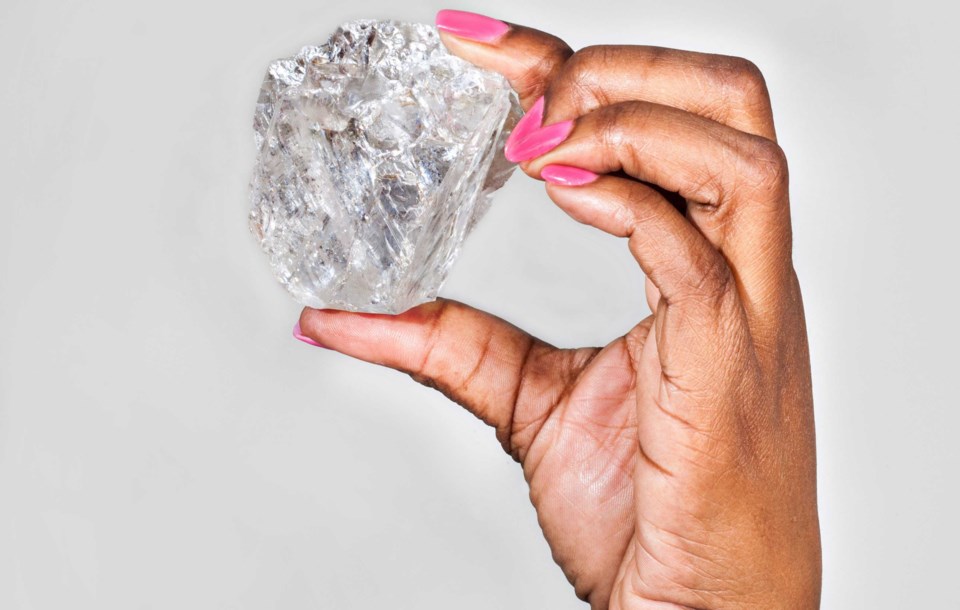The call from Botswana came at 1:28 a.m. on November 16.
William Lamb, the 44-year-old CEO of Lucara Diamond Corp. (TSX:LUC), who lives in Vancouver, was still asleep and didn’t return the call from his chief operating officer, Paul Day, until 4 a.m.
“He said, ‘Are you sitting down?’” Lamb told Business in Vancouver. “His comment was: ‘Congratulations – you are the CEO of the first company in 100 years to recover a stone over 1,000 carats.’”
In a discovery that would make headlines around the world and turn Lamb into something of a mining rock star, Lucara, a small junior mining company backed by the Lundin family, had just unearthed the second-largest diamond ever discovered.
“Nobody alive has ever held a stone this big,” Lamb said.
Weighing in at 1,111 carats, the Lucara diamond isn’t just big – about the size of an avocado – it’s also pure, a Type IIa diamond. (Fewer than 2% of the world’s diamonds are rated Type IIa).
Type IIa diamonds generally fetch prices of about US$60,000 per carat. That would put the Lucara stone at roughly US$67 million on per-carat calculation, but when gems are this big, those calculations go out the window. There is a historic value that can make them literally priceless.
After having the stone cleaned, photographed and secured, the company announced the find on November 18, sending the company’s stock up 30% in a single day and generating massive media coverage.

The Lucara diamond, shown here, is the second-largest ever found. Weighing in at 1,111 carats,
it measures 65 by 56 by 40 millimetres. It is a Type 11a stone. Fewer than 2% of the world’s diamonds are classed Type IIa | Submitted
Less publicized was that, the very next day, the company announced it had also recovered an 813-carat stone (the world’s sixth-largest diamond) and a 374-carat stone. It was like winning the lottery twice in 48 hours.
The stones are coming from Lucara’s Karowe mine in Botswana. Since producing its first stone on April 4, 2012, the Karowe mine has produced 95 diamonds that weigh 100 carats or more. The mine is already more than paid for and the company could easily build another one of the same size and still not go into debt.
Lamb said the company doesn’t plan to put a price on the diamond and will not sell it through the usual tendering process.
Asked if he is getting calls from Saudi princes and Hong Kong billionaires with offers to buy the diamond, Lamb said: “The Hong Kong one came through this morning: ‘My boss wants to buy the diamond, no matter what the price.’”
But Lamb said the company is in no rush to sell it. He said there may be more value in the stone’s story than in its price tag.
“For us to now just within a week flog it to somebody because they wrote the biggest cheque [is unlikely],” he said. “I think there’s more value to be gained for Botswana if we actually can extend it and make it into more of a story.”
Lamb’s own story begins in Johannesburg, South Africa, where he was born and raised. He attended the Technikon Witwatersrand – South Africa’s version of a polytechnic school – where he earned a diploma in extraction metallurgy. He was only 17 when he went to work for Rand Mines.
He later earned an MBA from Edinburgh Business School. But by that time, he had already worked for a number of mining companies, including De Beers, as a metallurgist for coal, gold and chrome mines.
In 2001, De Beers sent Lamb and his wife, Paula Lamb, to Canada for a six-month stint to work on De Beers’ Snap Lake diamond mine. Although the mine is in the Northwest Territories, Lamb and his wife spent most of their time in Toronto.
“When I got back to Johannesburg, I said, ‘If there’s any opportunity for positions in Canada, please keep me in mind,’” Lamb said.
In 2002, De Beers sent him back to Canada to work as senior project metallurgical superintendent, putting him in charge of the technical side of the company’s four Canadian projects.
A friend of his in the mining business urged him to seek out Lukas Lundin, the chairman of the Lundin Group, which was just getting into diamond exploration and development. So while on a trip to Vancouver in 2008, Lamb arranged a breakfast meeting with Paul Conibear, CEO for Lundin Mining (TSX:LUN), and Lukas Lundin himself.
Four weeks later, Lamb was hired to head up a new diamond company, Lucara Diamond – then nothing more than a shell company with an option on a property in Lesotho.
While the company was focused on developing the Mothae diamond property in Lesotho, Lamb got a cryptic text message from a friend via the friend’s wife’s phone: “Do you have $42 million? Because you may need it by the end of the week.”

Submitted
A few days later, he made up an excuse to call someone he knew with African Diamonds, which co-owned a promising kimberlite property called AK6 with De Beers.
“At the end of the conversation, I said, ‘How are things going with AK6?’ And he said, ‘Why – do you have $42 million?’ I said, ‘Hang on just a sec,’ and I ran into Lukas’ office and said to Lukas, ‘Do you have $42 million?’
“He probably gets that question more than most. He asked me what it was for, and by the following Friday we had a bank guarantee that De Beers was willing to accept.”
Lucara acquired a 70% stake in AK6, and when African Diamonds could not come up with its share of the capital needed to build the mine, Lucara bought it out, and now owns 100%.
Lucara got a $50 million debenture from the Lundin family and a $4 million credit facility from Scotiabank to build the Karowe mine. The company broke ground in September 2010, and on April 4, 2012, it produced its first diamond.
The mine employs 490 people, and the Botswana government gets a 10% royalty, plus taxes.
The initial capital outlay for the Karowe mine was $120 million, followed by another $55 million on an optimization project that included a relatively new X-ray technology for detecting diamonds called XTC, which has proven highly successful.
“At the end of 2013, we had US$49 million in the bank, we paid back Lukas his full $50 million and we paid back Scotia their money,” Lamb said.
The company now has $122 million in cash, no debt and an unsold inventory that has been ballparked at $100 million.
“So with the cash that we have now, and the inventory that we’ve got, we could actually do everything again and still have change,” Lamb said.
Lamb said Lucara’s spectacular success has been a combination of skill and luck. And though he doesn’t have a crystal ball, he does own a Magic 8 Ball that he uses as a business tool.
“Every one of the senior people has a Magic 8 Ball,” he said. “I give it to them when they join. I say, ‘This is a William Lamb management tool.’”
It’s not really used for prognostication – it’s a focusing tool. The idea is to get people to examine every possible answer to a question and anticipate all possible outcomes.
“Management is all about risk. It’s being able to foresee what could potentially go wrong and make sure you can mitigate it if it goes pear-shaped.”
A former triathlon and duathlon athlete, Lamb has represented South Africa in world championships. Two of his fellow executives are also former elite athletes. His work and travel schedule doesn’t allow him to compete so much these days, although he and his wife are planning to run the original marathon in Greece next year. •




